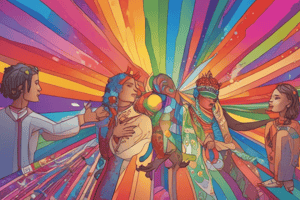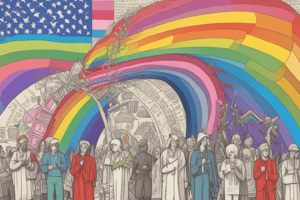Podcast
Questions and Answers
When was the first gay rights organization, the Scientific-Humanitarian Committee, founded?
When was the first gay rights organization, the Scientific-Humanitarian Committee, founded?
- 1907
- 1897 (correct)
- 1887
- 1917
What was a significant consequence of the AIDS epidemic of the 1980s for the LGBTQ community?
What was a significant consequence of the AIDS epidemic of the 1980s for the LGBTQ community?
- Increased discrimination against LGBTQ individuals
- Further mobilization and organization within the LGBTQ community (correct)
- The repeal of LGBTQ rights laws in several countries
- The establishment of the first LGBTQ-specific healthcare system
What is the term for an individual who does not identify with traditional sexual orientation labels?
What is the term for an individual who does not identify with traditional sexual orientation labels?
- Non-binary
- Queer (correct)
- Asexual
- Pansexual
What is the term for an individual's internal sense of being male, female, or something else?
What is the term for an individual's internal sense of being male, female, or something else?
What is the term for the ways in which an individual presents their gender to the world?
What is the term for the ways in which an individual presents their gender to the world?
What is the term for an individual whose gender identity aligns with their biological sex?
What is the term for an individual whose gender identity aligns with their biological sex?
What is the term for an individual who expresses both male and female elements in their gender expression?
What is the term for an individual who expresses both male and female elements in their gender expression?
What was a significant turning point in the LGBTQ rights movement?
What was a significant turning point in the LGBTQ rights movement?
Flashcards are hidden until you start studying
Study Notes
LGBTQ History
- The modern LGBTQ movement began in the late 19th century, with the first gay rights organization, the Scientific-Humanitarian Committee, founded in Berlin in 1897.
- The Stonewall Riots in 1969 marked a significant turning point in the LGBTQ rights movement, with protests and demonstrations leading to increased visibility and activism.
- The AIDS epidemic of the 1980s led to further mobilization and organization within the LGBTQ community, with activists demanding greater recognition and support.
- In recent years, there have been significant advances in LGBTQ rights, including the legalization of same-sex marriage in many countries and the repeal of "Don't Ask, Don't Tell" in the US military.
Sexual Orientation
- Sexual orientation refers to an individual's emotional, romantic, or sexual attraction to others, which can be:
- Heterosexual (opposite-sex attracted)
- Homosexual (same-sex attracted)
- Bisexual (attracted to both sexes)
- Asexual (not sexually attracted to anyone)
- Pansexual (attracted to people regardless of gender)
- Queer (does not identify with traditional labels)
- Sexual orientation is distinct from gender identity and expression
- Sexual orientation is generally considered to be an innate and unchangeable aspect of a person's identity
Gender Identity
- Gender identity refers to an individual's internal sense of being male, female, or something else, which may or may not align with their biological sex
- Gender identity is distinct from sexual orientation and gender expression
- Common gender identities include:
- Cisgender (gender identity aligns with biological sex)
- Transgender (gender identity does not align with biological sex)
- Non-binary (gender identity is neither male nor female)
- Genderqueer (gender identity is a combination of male and female)
- Two-Spirit (gender identity is a combination of male and female, specific to Indigenous cultures)
Gender Expression
- Gender expression refers to the ways in which an individual presents their gender to the world, through:
- Clothing and appearance
- Behaviors and mannerisms
- Names and pronouns
- Gender expression is distinct from gender identity and sexual orientation
- Gender expression can be:
- Conforming (aligns with traditional gender norms)
- Non-conforming (does not align with traditional gender norms)
- Gender-neutral (does not express gender)
- Androgynous (expresses both male and female elements)
LGBTQ History
- The modern LGBTQ movement began in the late 19th century with the first gay rights organization, the Scientific-Humanitarian Committee, established in Berlin in 1897.
- The Stonewall Riots in 1969 marked a significant turning point in the LGBTQ rights movement, leading to increased visibility and activism through protests and demonstrations.
- The AIDS epidemic of the 1980s prompted further mobilization and organization within the LGBTQ community, with activists demanding greater recognition and support.
- In recent years, there have been significant advances in LGBTQ rights, including the legalization of same-sex marriage in many countries and the repeal of "Don't Ask, Don't Tell" in the US military.
Sexual Orientation
- Sexual orientation refers to an individual's emotional, romantic, or sexual attraction to others.
- Types of sexual orientation include: • Heterosexual (opposite-sex attracted) • Homosexual (same-sex attracted) • Bisexual (attracted to both sexes) • Asexual (not sexually attracted to anyone) • Pansexual (attracted to people regardless of gender) • Queer (does not identify with traditional labels)
- Sexual orientation is distinct from gender identity and expression.
- Sexual orientation is generally considered to be an innate and unchangeable aspect of a person's identity.
Gender Identity
- Gender identity refers to an individual's internal sense of being male, female, or something else, which may or may not align with their biological sex.
- Gender identity is distinct from sexual orientation and gender expression.
- Common gender identities include: • Cisgender (gender identity aligns with biological sex) • Transgender (gender identity does not align with biological sex) • Non-binary (gender identity is neither male nor female) • Genderqueer (gender identity is a combination of male and female) • Two-Spirit (gender identity is a combination of male and female, specific to Indigenous cultures)
Gender Expression
- Gender expression refers to the ways in which an individual presents their gender to the world.
- Gender expression includes: • Clothing and appearance • Behaviors and mannerisms • Names and pronouns
- Gender expression is distinct from gender identity and sexual orientation.
- Gender expression can be: • Conforming (aligns with traditional gender norms) • Non-conforming (does not align with traditional gender norms) • Gender-neutral (does not express gender) • Androgynous (expresses both male and female elements)
Studying That Suits You
Use AI to generate personalized quizzes and flashcards to suit your learning preferences.




